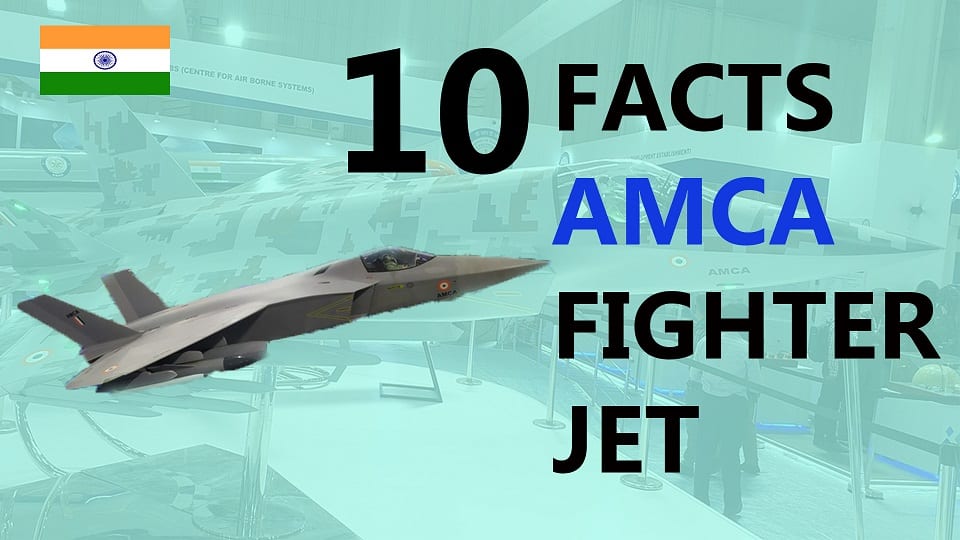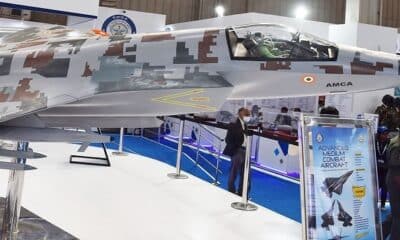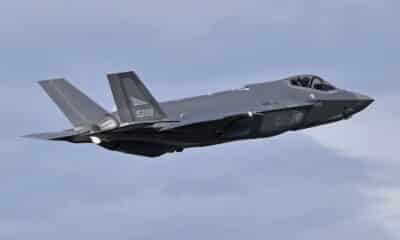Aerospace
10 features of the fighter jet made in India, the AMCA 5.5 gen.
air superiority fighter for the Indian Air Force and the Indian Navy, which likely satisfies the need for a fighter jet of the newest generation

The most anticipated aircraft for Indian defence is the Advanced Medium Combat Aircraft (AMCA) is an Indian programme to develop a stealth, multirole, air superiority fighter for the Indian Air Force and the Indian Navy, which likely satisfies the need for a fighter jet of the newest generation that can compete with western aircraft. In this video, we present some information and fascinating facts about this aircraft. Let’s begin.
1. This aircraft will be a fighter jet of the 5.5th generation.
AMCA will be a twin-engine, single-seat aircraft. The AMCA Mark 1 will have 5.5-generation technologies, while the Mark 2 will gradually upgrade to 6-generation technologies. The AMCA is a capable successor to the Sukhoi Su-30MKI air superiority fighter, which is the mainstay of the IAF fighter fleet. It is designed to carry out a variety of missions, including air superiority, ground strikes, suppression of enemy air defences (SEAD), and electronic warfare (EW). The AMCA design is enhanced for supercruise capability and low radar cross-section.
2. By 2026 AMCA may have its first maiden flight
ADA plans to roll out the first AMCA in 2026 followed by four more AMCAs that will cost 900 crores each initially, but the prices will fall when it enters full-scale production but it is still cheaper than Rafale which was brought for Rs 920 Crores.
3. The AMCA features advanced situational awareness
Advanced situational awareness will be present in AMCA. This is made possible by multi-spectral sensors positioned throughout the airframe, giving the pilot 360-degree visibility without the need to manoeuvre the fighter. An AMCA pilot would identify and eliminate the target without the adversary is aware of the danger. The 3D audio warning system and voice-activated command capability in the cockpit will lighten the load on pilots and allow them to concentrate more on operations.
4. It is featured with the electronic pilot
Imagine how challenging it would be to fly an aircraft while juggling many tasks. The AMCA is currently being developed and will have sophisticated avionics, including an electronic pilot function. A fighter platform typically needs two pilots. One is a pilot who flies, while the other is a mission pilot (who directs the flying pilot). Only one cockpit and an electronic pilot will be present on this jet. As a way to improve situational awareness and collaborate with the advanced electronic warfare (EW) suite onboard the AMCA, distributed passive sensors with AI-assisted multi-sensor data fusion are anticipated. even though it includes a health-monitoring system that is constantly updating
5. It has a weapon capable of up to 5.5 tonnes.
This aircraft will be able to carry more weapons than the Tejas aircraft, which is how most fighter jets gauge their power. It will weigh 25 tonnes and have a 1,500 kg internal payload, 5,000 kg external payload, and 6,500 kg internal fuel capacity. Its top speed will be 2600 km/h. It will have a 23mm cannon and 14 hard points.
6. It travels at a 2.15 Mach rate.
In addition to being able to carry weapons, fighter jets must also be quick to react to enemy attacks and swiftly leave enemy territory or fighter target areas. The AMCA can travel at a peak speed of about 2,600 km/hr and has a 1,620 km combat range.
7. The AMCA will have numerous sophisticated missiles.
This fighter plane was derived from the Tejas, an earlier model. since HAL realised the primary goals and advancements needed for AMCA for future aviation projects when constructing aircraft. In collaboration with international suppliers and via innovative research for newer weapons, the Defense is advancing its weaponry. The Brahmos air-to-ground missile, ASTRA, RUDRAM, Laser guided, and precision munition pods will all be made available by the AMCA. Radar and infrared search and tracking features are some additional elements that aid aircraft detection.
8. AMCA might be able to deep strike adversary fighters.
When we are looking into enemy territory with a lot of information and details, the field fighter needs to connect to a ground-based support team or another aircraft to check target coordinations, but in the AMCA, this feature will be built into the system and can be used to carry out a deep strike without the help of the ground or other aircraft. The F35 was the sole platform with comparable capabilities as of this date.
9. It is a stealth fighter created domestically.
The fighter jet’s stealth feature is what makes it special since it allows it to leave the territory without being detected by radar. It should be equipped with the appropriate avionics, radar system, and airframe structure to develop this technology. The majority of fifth-generation fighter jets have stealth capability. With the AMCA, India might become the fourth nation to field a stealth fighter aircraft that was designed domestically.
10. The main engine developer for AMCA is Safran.
When Safran has a pre-production engine 7 years after the contract is signed, it will use the Dassault-owned Rafale fighter jet as a Flying Testbed for the engine development. Safran will first produce 3 core and 4 prototype engines at its factory in France where the GTRE team will fill in. India will make the new 110kN engine the default engine for the AMCA programme, the Tejas Mk2 programme (re-engined from F414), and the Naval TEDBF programme, which could see the manufacturing of nearly 1000 engines in the next 20 to 30 years plus 100 more engine variants for other programmes, in order to make the joint venture profitable and recoup its investment.
Please share your thoughts about this aircraft in the comments section.

Aerospace
Indigo will soon launch Air Taxi Service in India

InterGlobe Enterprises, the parent brand of IndiGo, is set to revolutionize travel in India with its upcoming air taxi service.
Scheduled for a potential launch in 2026, this innovative venture promises a seamless journey for passengers between two bustling hubs. Delhi and Gurgaon in Haryana. The forthcoming service is projected to revolutionize the daily commute, offering passengers a swift aerial journey covering the distance in a mere 7 minutes.
This remarkable efficiency contrasts starkly with the conventional 90-minute drive, underscoring the immense time-saving potential for commuters. The anticipated fare, ranging from Rs 2,000-3,000, makes this innovative mode of transport not only swift but also remarkably competitive in pricing.
At the heart of this ambitious endeavor lies a strategic partnership with Archer Aviation, a pioneer in electric vertical takeoff and landing (eVTOL) aircraft technology. Under this collaboration, Archer will supply 200 state-of-the-art eVTOL aircraft, representing an investment of US$ 1 billion. These cutting-edge aircraft, capable of accommodating up to four passengers alongside the pilot, epitomize the future of sustainable air travel.
Powered by six battery packs, Archer’s eVTOL aircraft boast rapid charging capabilities, enabling a swift turnaround between flights. With a charging time of just 30-40 minutes, these eco-friendly aircraft ensure minimal downtime, maximizing operational efficiency.
Similar services are anticipated to be introduced by the joint venture in Bengaluru and Mumbai as well. Nevertheless, the service rollout period has not yet been made public by the company. Next year, it is anticipated to get its certification. Following this, the company will start the certification procedure with the Directorate General of Civil Aviation (DGCA).
Aerospace
Which is bigger 777x or 787 aircraft ?

The 777X is a new series of the Boeing 777 family and is designed to be larger and more efficient than its predecessor. It features two variants: the 777-8 and the 777-9, being the larger of the two.
The Boeing 777X emerges as the larger sibling within the Boeing family, representing a significant leap forward in both size and efficiency. Comprising two variants, the 777-8 and the 777-9, the latter takes the crown as the larger of the two. With its expansive fuselage and impressive wingspan, the 777X is tailored for long-range journeys and boasts a substantial passenger capacity.
On the other hand, the Boeing 787, affectionately known as the Dreamliner, occupies a niche in the market as a smaller yet formidable aircraft designed for medium to long-range flights. Its distinguishing feature lies in its composite fuselage, a technological marvel that renders it lighter and more fuel-efficient compared to conventional aluminum counterparts. The Boeing 777X is larger than the Boeing 787 aircraft.
When it comes to passenger capacity, the 777-9 reigns supreme, typically accommodating a sizeable contingent of 400-425 passengers in its standard configuration. In contrast, the 787, with its more modest dimensions, typically carries between 240-290 passengers, depending on the variant and layout.
One of the remarkable innovations introduced with the 777X is its folding wingtips, a feature designed to address the logistical challenges of accommodating such a large aircraft in conventional airport gates. These folding wingtips enable the 777X to retract its wings, allowing it to fit into gates designed for smaller aircraft while still reaping the benefits of an extended wingspan during flight, thereby enhancing fuel efficiency and operational flexibility
Aerospace
China Secures Production Certificate for Mass Production of Pilotless eVTOL Aircraft

The first passenger-carrying pilotless electric vertical takeoff and landing (eVTOL) aircraft in the world, the EH216-S, has received the Production Certificate for its eVTOL aircraft from the Civil Aviation Administration of China (CAAC).
This is a significant milestone for EHang Holdings Limited, the leading UAM technology platform company in the world. This outstanding accomplishment is another big step towards mass manufacturing for the eVTOL aircraft and the ensuing commercial operations, building on the ground-breaking acquisition of the Type Certificate and the Standard Airworthiness Certificate for the EH216-S.
The PC is a crucial certificate that the aircraft maker receives from the CAAC, the country’s aviation authority. By obtaining this certificate, EHang has demonstrated that it has set up a quality management system for mass production that satisfies the airworthiness regulation standards set forth by the CAAC, and the company has been given permission to continue producing mass quantities.
It is also a strong guarantee of the calibre of the goods made by EHang. Raw materials, supplier management, manufacturing organisation, production quality control, aircraft pre-delivery test, after-sales repair and maintenance, etc. are all included in the mass production quality management system for the EH216-S.
To ensure that every aircraft and its components that roll off the production line strictly adhere to the approved type design and safety requirements, the system sets clear guidelines and documentation for every step in the production procedure. This ensures comprehensive traceability and safety control.



























